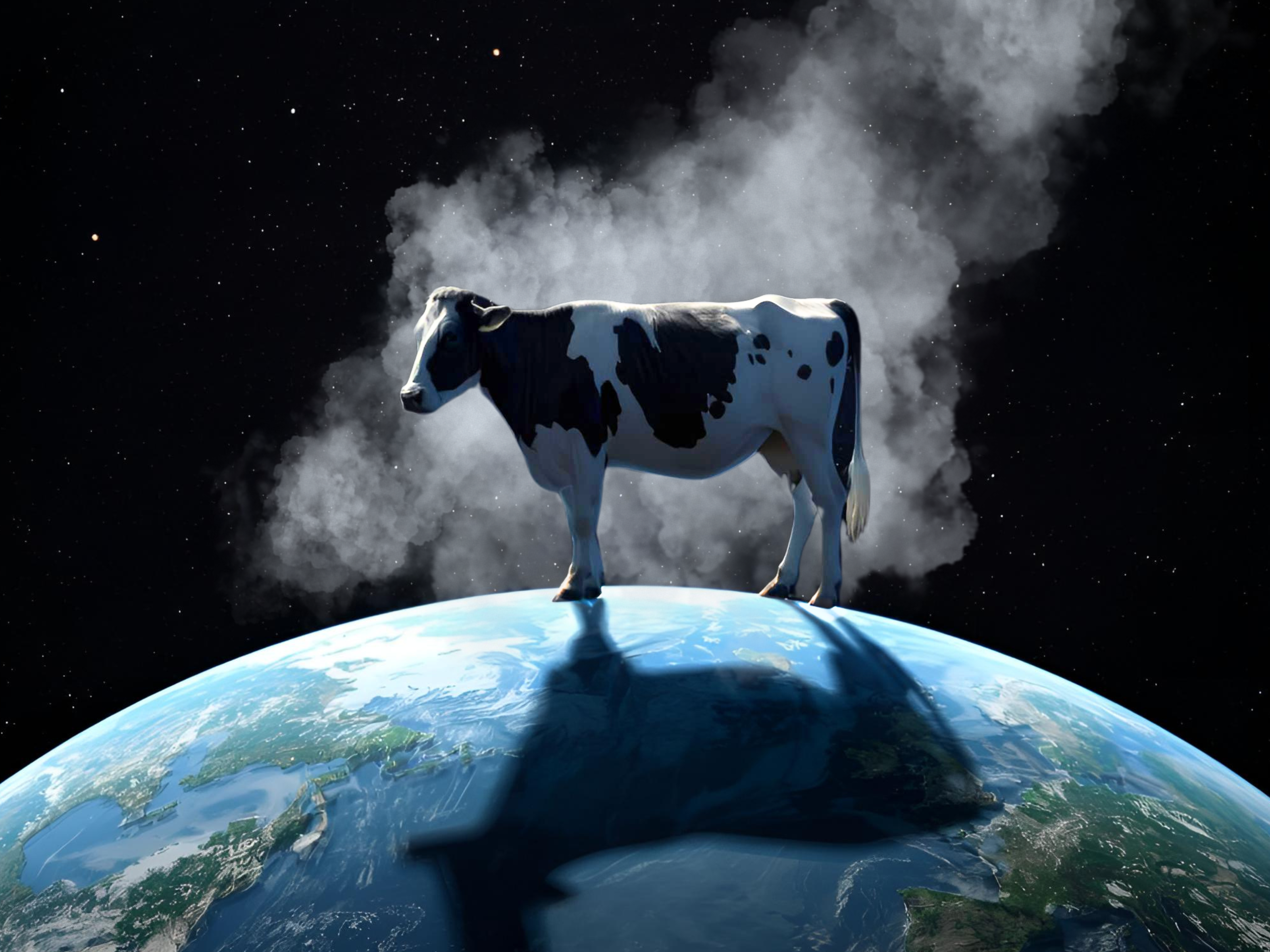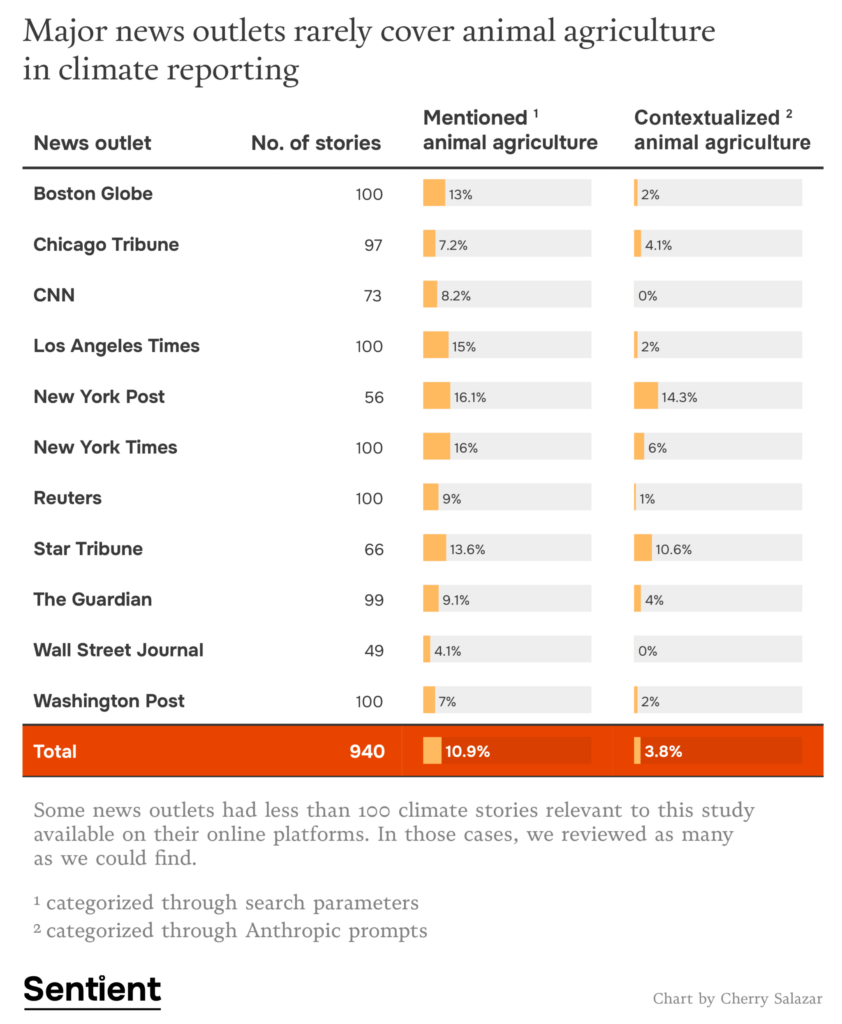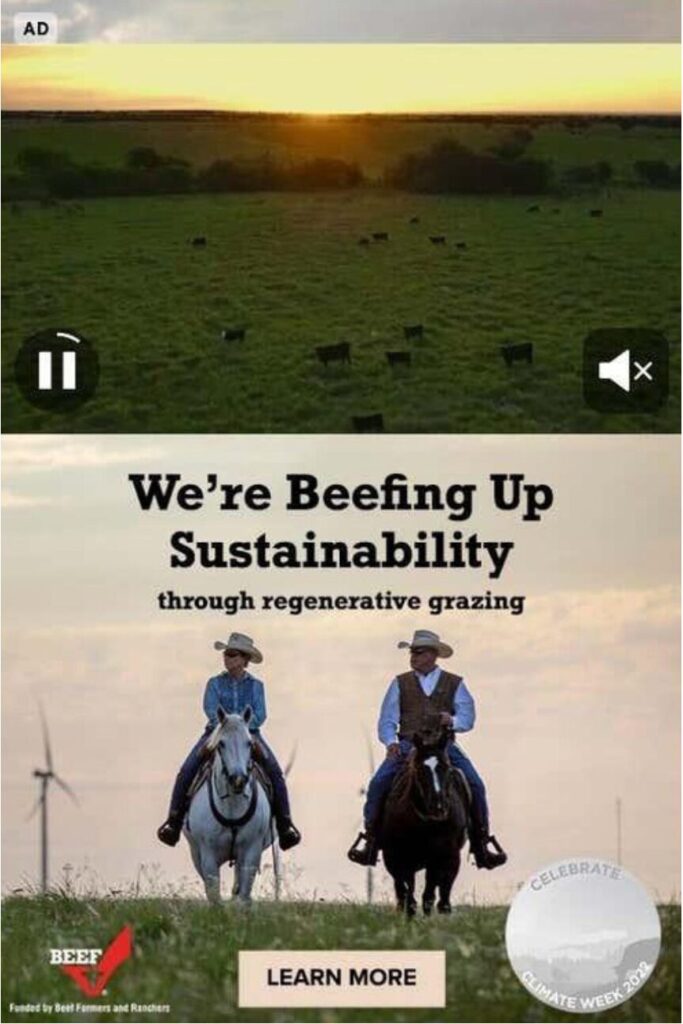
An analysis of hundreds of online articles from US media shows that less than 4% mention and contextualise the role of meat in climate change. Here’s why.
Globally, producing meat, dairy and other animal-based foods generates up to a fifth of all greenhouse gas emissions, and takes up 80% of Earth’s agricultural land.
In fact, according to one study, livestock farming is the leading cause of climate change. The growing appetite for animal proteins is only going to worsen things – according to the UN FAO, per capita demand for these foods is set to grow by 6% over the next decade.
It’s why over 200 of the world’s leading climate experts say livestock emissions must peak this year and be cut in half by 2030, identifying less meat and dairy consumption and fewer farmed animals as the most effective actions for emissions reduction. Plant-based alternatives, they suggest, should be considered the “best available foods” and prioritised in climate and agrifood policy.
If you didn’t know any of this, you’re not to blame.
New analysis by Sentient Media has revealed that only 11% of climate stories in 11 major US outlets mention animal agriculture as a cause of the climate crisis. And of the 940 articles, only 36 (or 3.8%) contextualised the link.
“Emissions from food are still very underreported,” Jenny Splitter, Sentient Media’s editor-in-chief, tells Green Queen.
New York Post leads the way, CNN and WSJ lag furthest behind

Sentient Media assessed stories from the Boston Globe, Chicago Tribune, CNN, Guardian, Los Angeles Times, New York Post, New York Times, Reuters, Star Tribune, Wall Street Journal, and Washington Post, screening them via detailed criteria.
Some of the search parameters for stories included “meat”, “dairy”, “livestock”, “chicken farm”, “cattle shelter”, “seafood”, and “fisheries”. Opinion pieces, syndicated stories, and articles that only mentioned climate change in passing were excluded.
Sentient Media used artificial intelligence to collate the data and then individually reviewed it for accuracy, and found that mining, manufacturing, and energy production (56%) were the most discussed topics in the reporting, followed by fossil fuels (50%) and transportation (34%).
Livestock farming was the least mentioned subject, despite being responsible for nearly 60% of emissions from the food system, itself the second-largest source of greenhouse gas production (behind fossil fuels).
The New York Post had the biggest share of stories contextualising the environmental impact of animal agriculture (14%), followed by the Star Tribune (11%).
Meanwhile, meat and dairy farming was mentioned in 16% of the New York Times’s climate stories, 15% in the Los Angeles Times, and 13% in the Boston Globe – although articles contextualising the link were far fewer, at 6%, 2%, and 2%, respectively.
On the other hand, only 4% of the Wall Street Journal’s climate articles mentioned animal agriculture, and none of them contextualised its impact. No CNN article did so either.
“Reporting on the climate impact of meat is tricky for a number of reasons – it’s personal and political, and there are fewer researchers working on measuring climate emissions from food as compared to other sources of emissions,” explains Splitter.
“But there is also an opportunity here. Eating less meat is one of the most effective forms of climate action, yet 74% of Americans think eating less meat would have little or no impact on climate change. Our job as journalists is to inform, and we’ve got an issue here that is ripe for more reporting.”

Livestock lobby a key driver, but media must highlight ‘bigger picture’
The attention on meat is solely lacking in the media at a time when consumption needs to fall faster than ever before. Many national dietary guidelines have been updated recently to put an emphasis on plant-based eating, and the US is mulling similar changes in its forthcoming recommendations.
Despite this, the US saw meat sales rise to all-time highs last year, as the protein craze took hold of the food system. Despite their environmental and health ills, raw milk and beef tallow are back in vogue, with more than a helping hand from health secretary Robert F Kennedy Jr. Plant-based meat products, derided for being ultra-processed, have witnessed consistent sales declines.
One major driver behind the lack of reporting on meat’s climate impact is the highly successful livestock lobby. “We know, thanks to documents surfaced by University of Miami researcher Jennifer Jacquet, that the beef industry has been aware of its climate impact since at least 1989, yet worked to downplay that impact to the public,” says Splitter.
“I see those efforts as helping to create an impression that beef’s climate impact is a matter of debate, when in fact it was a growing body of research showing that most food-related emissions are caused by livestock production.”

She doesn’t believe the underreporting on meat has to do with a lack of interest from readers. Rather, she adds, there’s a sense of burnout around topics as polarising as food and climate change.
“It’s really important to not just fact-check and debunk misinformation but also report stories that engage reader curiosity, like what initiatives for dietary change actually work? What are the limitations? Asking more questions is a good path towards better stories,” she says.
So how can the media dial up its coverage of livestock’s climate footprint? “One thing larger media outlets can do is to rely more on their beat reporters – in this case, the ones who have experience reporting on where food-related emissions come from,” suggests Splitter.
“If you are publishing a story on how ‘meat is cool again’ or a similar trend story that is basically about vibes, include accurate information so that readers come away more informed.
“Another pitfall to avoid is reporting on how a farmer will stay afloat amid rising temperatures without including the bigger picture of what drives food-related emissions and what it will take, according to the research, to mitigate those emissions, including what happens if we don’t do anything at all.
“That isn’t to say you shouldn’t include farmers – of course you should – but that is one aspect of a more complicated, and more interesting, story.”
The post Less Than 4% of US Media Climate Coverage Mentions Meat & Dairy’s Emissions Toll: New Analysis appeared first on Green Queen.
This post was originally published on Green Queen.